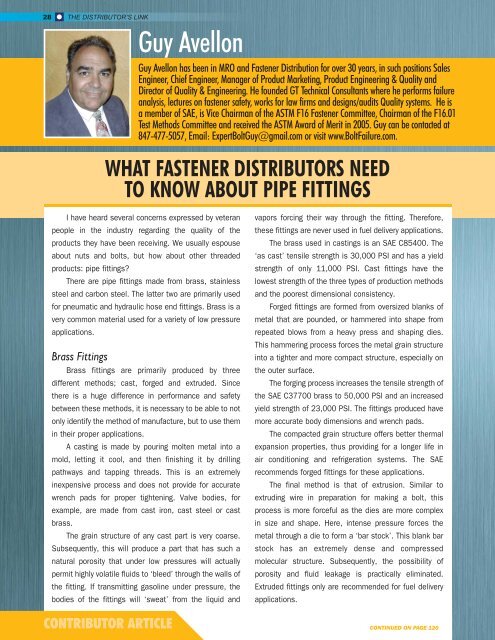WINTER 2016
Distributor's Link Magazine Winter Issue 2016 / Vol 39 No1
Distributor's Link Magazine Winter Issue 2016 / Vol 39 No1
Create successful ePaper yourself
Turn your PDF publications into a flip-book with our unique Google optimized e-Paper software.
28 THE DISTRIBUTOR’S LINK<br />
Guy Avellon<br />
Guy Avellon has been in MRO and Fastener Distribution for over 30 years, in such positions Sales<br />
Engineer, Chief Engineer, Manager of Product Marketing, Product Engineering & Quality and<br />
Director of Quality & Engineering. He founded GT Technical Consultants where he performs failure<br />
analysis, lectures on fastener safety, works for law firms and designs/audits Quality systems. He is<br />
a member of SAE, is Vice Chairman of the ASTM F16 Fastener Committee, Chairman of the F16.01<br />
Test Methods Committee and received the ASTM Award of Merit in 2005. Guy can be contacted at<br />
847-477-5057, Email: ExpertBoltGuy@gmail.com or visit www.BoltFailure.com.<br />
WHAT FASTENER DISTRIBUTORS NEED<br />
TO KNOW ABOUT PIPE FITTINGS<br />
I have heard several concerns expressed by veteran<br />
people in the industry regarding the quality of the<br />
products they have been receiving. We usually espouse<br />
about nuts and bolts, but how about other threaded<br />
products: pipe fittings?<br />
There are pipe fittings made from brass, stainless<br />
steel and carbon steel. The latter two are primarily used<br />
for pneumatic and hydraulic hose end fittings. Brass is a<br />
very common material used for a variety of low pressure<br />
applications.<br />
Brass Fittings<br />
Brass fittings are primarily produced by three<br />
different methods; cast, forged and extruded. Since<br />
there is a huge difference in performance and safety<br />
between these methods, it is necessary to be able to not<br />
only identify the method of manufacture, but to use them<br />
in their proper applications.<br />
A casting is made by pouring molten metal into a<br />
mold, letting it cool, and then finishing it by drilling<br />
pathways and tapping threads. This is an extremely<br />
inexpensive process and does not provide for accurate<br />
wrench pads for proper tightening. Valve bodies, for<br />
example, are made from cast iron, cast steel or cast<br />
brass.<br />
The grain structure of any cast part is very coarse.<br />
Subsequently, this will produce a part that has such a<br />
natural porosity that under low pressures will actually<br />
permit highly volatile fluids to ‘bleed’ through the walls of<br />
the fitting. If transmitting gasoline under pressure, the<br />
bodies of the fittings will ‘sweat’ from the liquid and<br />
CONTRIBUTOR ARTICLE<br />
vapors forcing their way through the fitting. Therefore,<br />
these fittings are never used in fuel delivery applications.<br />
The brass used in castings is an SAE C85400. The<br />
‘as cast’ tensile strength is 30,000 PSI and has a yield<br />
strength of only 11,000 PSI. Cast fittings have the<br />
lowest strength of the three types of production methods<br />
and the poorest dimensional consistency.<br />
Forged fittings are formed from oversized blanks of<br />
metal that are pounded, or hammered into shape from<br />
repeated blows from a heavy press and shaping dies.<br />
This hammering process forces the metal grain structure<br />
into a tighter and more compact structure, especially on<br />
the outer surface.<br />
The forging process increases the tensile strength of<br />
the SAE C37700 brass to 50,000 PSI and an increased<br />
yield strength of 23,000 PSI. The fittings produced have<br />
more accurate body dimensions and wrench pads.<br />
The compacted grain structure offers better thermal<br />
expansion properties, thus providing for a longer life in<br />
air conditioning and refrigeration systems. The SAE<br />
recommends forged fittings for these applications.<br />
The final method is that of extrusion. Similar to<br />
extruding wire in preparation for making a bolt, this<br />
process is more forceful as the dies are more complex<br />
in size and shape. Here, intense pressure forces the<br />
metal through a die to form a ‘bar stock’. This blank bar<br />
stock has an extremely dense and compressed<br />
molecular structure. Subsequently, the possibility of<br />
porosity and fluid leakage is practically eliminated.<br />
Extruded fittings only are recommended for fuel delivery<br />
applications.<br />
CONTINUED ON PAGE 120

















